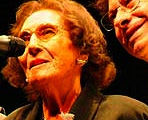1912-2008
|
When these famous stars die at such an advanced age, it’s the custom to proclaim «the end of an era!» In the case of Pilar López, we could speak of the end of several eras, because doña Pilar López Julver was witness to, and participated in the long gradual revolution in flamenco and Spanish dance that went from the end of the café cantante period, through the beginnings of Vicente Escucero or her own sister, the legendary Argentinita, right up until a few days ago when she died at the age of 95.
She also rubbed shoulders with Macarrona, Malena, Pastora Imperio, Carmen Amaya and countless other stars throughout her long lifetime. It wouldn’t be an exaggeration to say that via the influence of her dynamic sister, she designed flamenco dance for the theater. Such extensive experience makes for a lot of dates and details, but the most noteworthy aspect of doña Pilar was always the great stars that came out of her company with important lessons learned and assimilated, who blazed new trails that never strayed too far from the aesthetic Pilar instilled in them. The best-known names of this privileged group are Antonio Gades, Mario Maya and El Güito, but also important were dancers such as José Greco, Alejandro Vega, Manolo Vargas and Roberto Ximénez, each one of whom displayed the elegance and sobriety Pilar López conveyed to them. For three decades, Pilar López travelled to the world’s greatest theaters with her entire company, founded in 1946, establishing a mixed repertoire of Spanish and flamenco dance that would be the model to follow for countless artists and groups. Many of her choreographies have withstood the test of time and become classics, even in flamenco, most notably her version of the caña which is included in the film Duende y Misterio del Flamenco, by Edgar Neville, where Alejandro Vega is her elegant partner, a picture-postcard for posterity. Pilar López marked not only an era, but the entire 20th century, and her absence is mourned by all flamenco fans. AWARDS AND DECORATIONS To the memory in art and wisdom of my maestra Doña Pilar López by Mario Maya |
